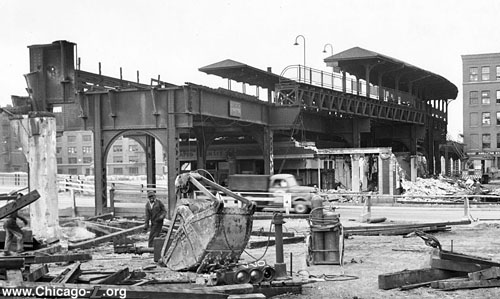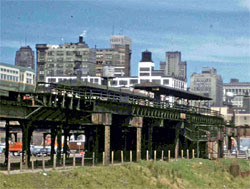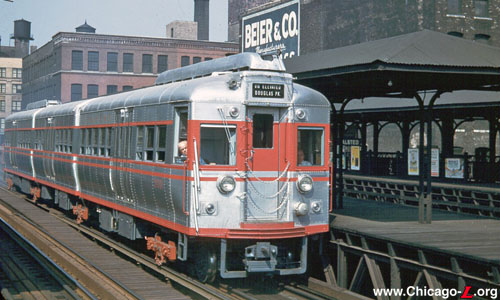.
|

Demolition of the Halsted station on the former Metropolitan Division elevated is already well underway in this view looking southwest on July 18, 1958, less than a month after the station closed. While sections have been removed, the design and arrangement of the former station remain evident. Removal of this section permitted the City to proceed with construction of interchange ramps between the new Northwest Expressway and the Congress Expressway. For a larger view, click here. (CTA photo)
|
Halsted
(800W/400S)
Halsted Street and Van
Buren Street, Near West Side
Service
Notes:

|
Garfield
Park/Douglas Lines
|
Quick Facts:
Address: 420 S. Halsted Street
Established: May 6, 1895
Original Line: Metropolitan West Side Elevated Railroad
Previous Names: none
|
Skip-Stop Type:
|

|
Station
(1951-1953)
|

|
Station
(1953-1958)
|
Rebuilt: n/a
Status: Demolished
History:
The Halsted station opened in 1895 when the Metropolitan "L"
first opened. It was located on the four-track Metropolitan
main line, on which all three branches of the Met -- the
Northwest
branch, Garfield Park
branch, and Douglas
Park branch -- entered downtown Chicago. An large S-curve was
located just east of the station, which was a popular location for
railfan photos, especially after the surrounding buildings were
cleared for the construction of the Eisenhower Expressway.
An 1897 inventory of the Metropolitan "L" described the station houses on the Met main line as being "similar to those of the Garfield Park branch, but larger." Indeed, like these, the station houses at Halsted and the other Met main line stations were constructed of red pressed brick with stone sills and foundations. The most obvious difference in design from their Garfield Park (and Northwest branch) brethren is the lack of the semicircular bay/portico on front which was characteristic of these other Met headhouses, instead having a flat front elevation. The interior was described as having painted walls and ceiling with hard wood finishes, and equipped with a ticket booth, newsstand, water closet, and a water heater in the basement.
As originally built, all four Met main line stations, including Halsted, had dual island platforms, each set between the pairs of outer and inner tracks. The stairs and platforms were constructed of
wood on a steel structure. Each platform had a short canopy in the
center of the platform, covering the stairs and about 2/3 of the original platform length. The canopy frame was iron, with a hipped roof of corrugated tin. The inner tracks at each station were tangent, while the outer tracks bowed out to make room for the platform between the outer and inner tracks.
Between 1898 and 1914, the track and platform configurations at Halsted, Racine and Laflin were altered. A valuation report for the Metropolitan elevated described the original island platforms as having "very sharp swings in the track at each end of the platform. These were so sharp as to be a source of danger..." As a result, the Met embarked on a project to shift the structure, install new foundations, reconfigure the platforms, and change the profile of the tracks on both sides of the platforms. It is not clear why the project took 16 years, even if done under traffic, nor if it was done one station at a time or if more than one station was worked on at a time. At Halsted, the result was a change to a three-platform configuration, with an island platform between the two inner tracks and side platforms outboard of the two outer tracks.
The Halsted station house was also renovated and expanded, probably in the 1920s. The rebuilt entrance was executed in off-white terra cotta, designed in the Beaux-Arts style common to many stations built or rebuilt in this period under the direction of the elevated's chief architect, Arthur Gerber. The renovated station house included retail spaces flanking the entrance to the station facility.
In 1951, trains between downtown and Logan
Square were rerouted from their Milwaukee-Paulina alignment via Marshfield and the Metropolitan Division main line into the Milwaukee-Dearborn
Subway, which continued under Milwaukee, Lake Street, Dearborn, and Congress, originally ending at LaSalle/Congress. Garfield
Park and Douglas
Park trains to and from the Loop,
however, continued to operate over the old Met
main line and through Halsted for the time being.

The Halsted station on the old Met main line is seen looking northeast toward downtown from the Peoria Street overpass over the Congress Expressway. A 2-car 6000-series train is approaching the station inbound on June 14, 1958, about a week before the station will close. Note that half the elevated structure and a third platform, which would've been closest to the camera, has already been removed, leaving just the two tracks and two platforms visible here. For a larger view, click here. (Photo by George Krambles, courtesy of the
Krambles-Peterson Archive) |
Within a couple years, however, the Met Division main line and Garfield Park branch began to be gradually abandoned to allow for its demolition to make way for the construction of the Congress Superhighway (later, Eisenhower Expressway). In September 1953, the Garfield
Park Line was rerouted via temporary ground-level trackage along
the south side of Van Buren Street between Sacramento and Aberdeen. This permitted demolition of the Garfield Park elevated structure between Sacramento and Marshfield for highway construction, but for the time being Douglas trains continued to use the Met main line east of Marshfield. The temporary ground-level Garfield tracks rejoined the elevated near Aberdeen, east of Racine station. During this period, all four tracks and three platforms at Halsted remained in use.
This would be short-lived, however. The next phase of abandonment came when Douglas trains were rerouted to the Loop via the Paulina Connector and Lake Street on April 4, 1954. This allowed for the abandonment of the Metropolitan main line elevated structure from Marshfield Junction to Sangamon Street, and with it the closure of Marshfield and Racine stations. This also meant only two of the four main line tracks between Sangamon and Market Junction were needed, since only Garfield Park trains remained to use the line. At the time of the withdrawal of Douglas service, Garfield trains used tracks 1 (the northernmost track) and 3, while Douglas trains used tracks 2 and 4; the change meant the side platform along track 4 at Halsted could be immediately closed. A month later, on May 2, 1954, a second step of the change was completed, with a modification to the track configuration west of Halsted station allowing eastbound Garfield trains from the ground-level tracks to continue via track 2 on the elevated, from Aberdeen Street east to a point west of Desplaines Street. This allowed track 3 to be abandoned and, with it and track 4 closed, the south half of the 4-track elevated structure, including the south (track 4) side platform at Halsted, could be demolished, making more room for expressway construction. At this point, the island platform at Halsted that had been between tracks 2 and 3 effectively became a side platform serving track 2.
While Halsted station remained open throughout the
highway construction project, the station was closed on June 22, 1958 when the
replacement Congress
Line in the median of the Eisenhower Expressway opened a few
hundred feet to the south. A replacement station, Halsted (renamed U of I-Halsted in 1965, now UIC-Halsted)
was opened in the Congress
Line. The CTA moved quickly after the Congress Line opened to demolish the Halsted station and the portion of the Garfield Park elevated it was on -- a contract to remove the first half-mile section of the structure, from just west of Desplaines Street to just east of Aberdeen Street, had already been awarded by July 1958. Demolition work started soon after.
|

Articulated 5000-series car 5001, shining in its original silver and red livery, is stopped on track 3 side of the island platform at Halsted, circa the early 1950s. For a larger view, click here. (Photo by Jim Northcutt, from the
Illinois Railway Museum Collection)
|
.





